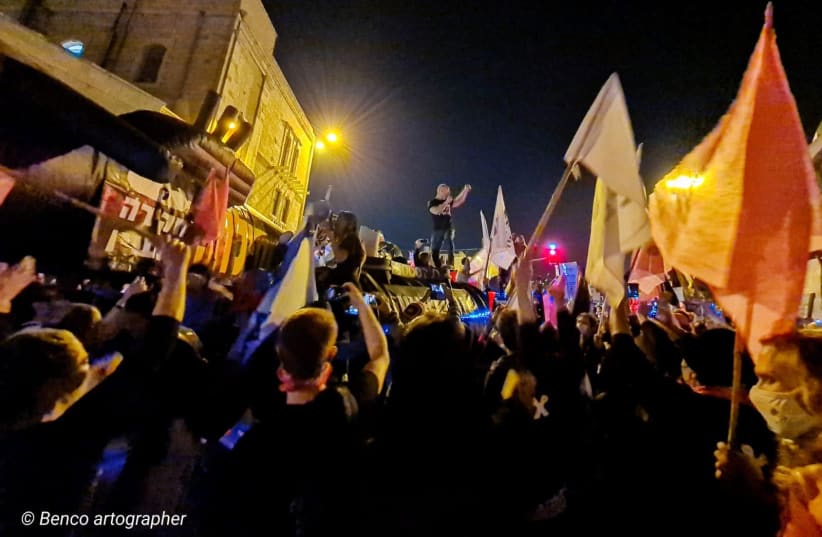At the height of the intifada, there were as many as 30 silent vigils in different parts of Israel. Almost every week for several years, there was an opposing smaller group of Women in Green and representatives of other right wing movements standing with national flags held aloft alongside the Prima Kings Hotel and demonstrating against the Women in Black. Sometimes they shouted something, but without megaphones, so the sounded didn’t really carry. The Women in Black came from various strata of society. Their common denominator was a desire to free Palestinians from Israeli rule. For the first five years, their numbers were strong, but after the Oslo Accords of 1993, they began to dwindle. They increased again when it became obvious that the Oslo process was an idyllic dream that was unlikely to become a reality. But with the aging and concessions to mortality of the original Women in Black, the movement more or less faded into oblivion. New demonstrators showed up at France Square to call for the release of Jonathan Pollard and the return home of abducted soldier Gilad Shalit, as well as for several other causes.
But nothing compared in size, volume or discomfort for the residents of Rehavia and Talbiyeh with the demonstrations that have taken place over the past eight months. In the early days, the demonstrators did show some concern for the residents of both neighborhoods by leaving small potted plants, accompanied by messages of apology outside front doors of apartments in many buildings. But it was a one-time gesture.
In her comprehensive article in last week’s In Jerusalem about the general situation, Peggy Cidor interviewed both residents and demonstrators, but perhaps because she does not live in these neighborhoods, may not have been aware that in addition to mega-demonstrations that take place on Saturday nights and the small around-the-clock vigil as close as anyone can get to the Prime Minister’s residence, there used to be a Thursday night demonstration in which public transport was diverted to another part of the city, plus a Friday morning gathering in which some woman with a horribly strident voice rising to a crescendo would blast her way through a megaphone for over an hour, after which there was a peaceful Kabbalat Shabbat on Friday afternoon with the singing of traditional songs that would disturb very few people, if any.
But on one recent Friday evening, a drummer came into Smolenskin Street, where the Prime Minister’s official residence is actually located, and began drumming louder and louder. Ahead of the heavy metal barriers that close off half the street, there are three apartment buildings with religiously observant apartment dwellers in each. When one of the residents opened a window, to ask the drummer to stop because he was disturbing the tranquility of Shabbat, the request was denied, and the volume increased. The resident had asked in Hebrew, but angry at the response yelled out an obscenity in English. The drummer still paid no attention, but a group of border police who had been further down the street, moved in the direction of the drummer and ordered him to leave – which he did.
On Sunday of this week, individual demonstrators were walking along Ahad Ha’am Street, and stopping people to convince them of their cause. Last week, some of them congregated on the traffic island between Ahad Ha’am and Smolenskin Streets, blocking the passage of people boarding or alighting from buses.
There are two WhatsApp groups: Talbiyeh and Rehavia against the Demonstrations; and the Talbiyeh Forum, which is actually run by the Ginot Ha’ir Community Center. Both groups exchange information and complaints about demonstrations, sometimes with photographs to prove the veracity of the content of the text. There are also complaints about other issues, such as early morning construction and demolition work.
Will there finally be peace and quiet after the elections? It all depends on the outcome of the vote.
■ WITH REGARD to demolitions, the first stage of demolitions on the site of the long-abandoned President Hotel on Ahad Ha’am Street has begun, scattering dust all over the balconies in Ahad Ha’am up to the Brenner intersection, with some people in Brenner Street also experiencing a dust storm. What has been demolished so far, is the section of the building that housed the Government Coins and Medals Corporation. The hotel per se is still standing at the time of going to press. It could hardly be described as intact given that most of the windows are broken, and homeless people, alcoholics and drug abusers, have caused serious damage to the interior.
Designed as a small boutique hotel by Alexander Friedman and Meir Rubin, the President opened in 1954 and was the first hotel in Jerusalem with a swimming pool. The hotel was a great favorite with diplomats and government officials. It was owned by the late Haim Shiff, a colorful and controversial figure who was among the pioneers of Israel’s tourism industry. Shiff owned or was part owner of hotels in Haifa, Jerusalem and Tel Aviv. Among his four hotels in Jerusalem, was the Diplomat, which now belongs to the US State Department and will eventually be an extension of the US Embassy.
greerfc@gmail.com
